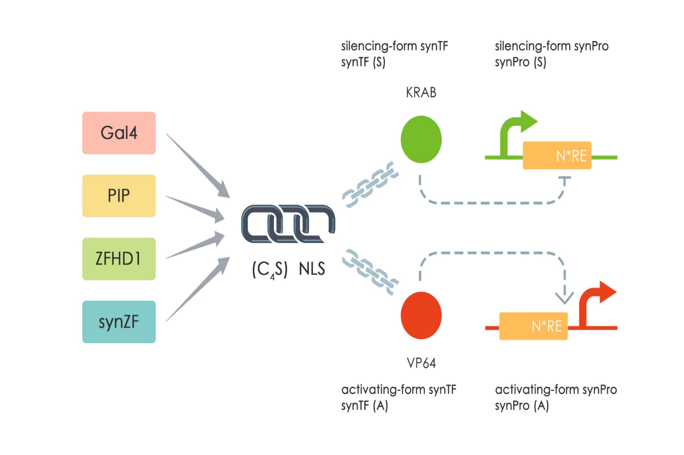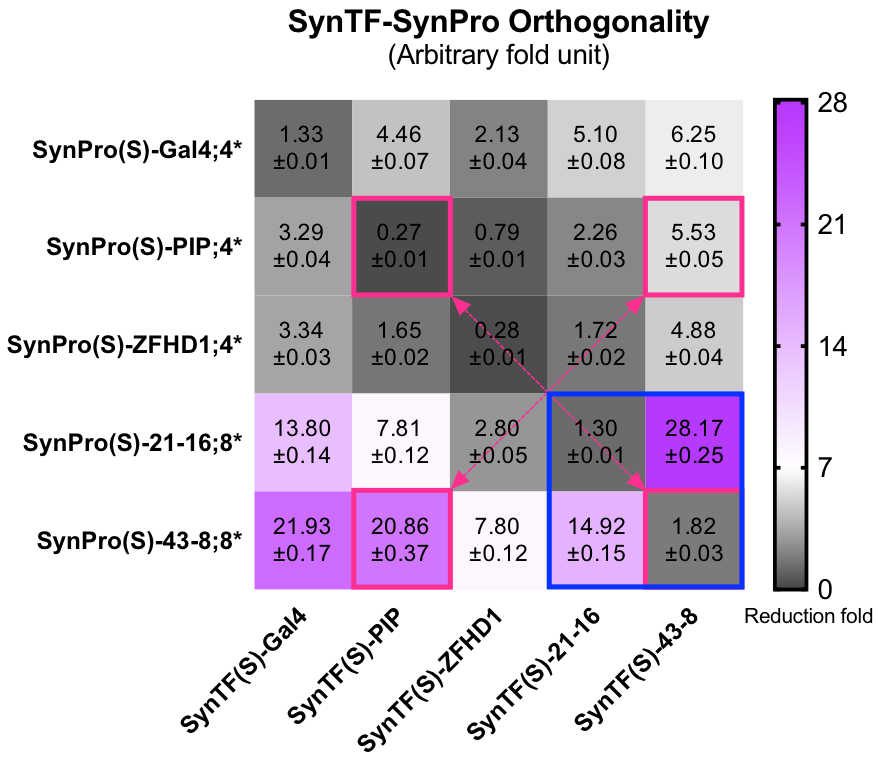Part:BBa_K2446038
ZF_PIP_KRAB
This part is one of our mammalian synthetic transcription factors (SynTFs) based on PIP DNA binding domain [1]. PIP_KRAB (or TF-KRAB-2 in our project) containing three core domains from N-terminal to C-terminal: PIP DNA binding domain, nuclear location sequence and KRAB transcription regulating domain [2].And a (G4S) linker was added between DBD and NLS for providing region flexibility [3]. PIP-DBD enable binding to specific DNA sequences, so that we can use PIP-KRAB as a specific transcription factors to repress the expression of our mammalian synthetic promoter SV40_4_PIP ( BBa_K2446034).
Figure 1: t Design of the SynTF-SynPros
The information of other SynTF-SynPros is showed in the table below.
| SynTFs | SynPros |
|---|---|
| Gal4-KRAB(TF-KRAB-1) BBa_K2446037 | Sv40-UAS(Sv40-UAS) BBa_K2446036 |
| ZF_PIP_KRAB(TF-KRAB-2) BBa_K2446045 | SV40_2/4/8_PIP BBa_K2446033/BBa_K2446034/BBa_K2446035 |
| ZF_21-16KRAB(TF-KRAB-3) BBa_K2446039 | SV40_8_ZF_21-16 BBa_K2446030 |
| ZF_42-10_KRAB(TF-KRAB-4) BBa_K2446040 | SV40_8_ZF_42-10 BBa_K2446025 |
| ZF_43-8_KRAB(TF-KRAB-5) BBa_K2446041 | SV40_2/4/8_ZF_43-8 BBa_K2446026/BBa_K2446027/BBa_K2446028 |
| ZF_54-8_KRAB(TF-KRAB-6) BBa_K2446042 | SV40_8_ZF_54-8 BBa_K2446029 |
| ZFHD1_KRAB(TF-KRAB-7) BBa_K2446043 | SV40_4_ZFHD1 BBa_K2446032 |
Sequence and Features
- 10COMPATIBLE WITH RFC[10]
- 12COMPATIBLE WITH RFC[12]
- 21COMPATIBLE WITH RFC[21]
- 23COMPATIBLE WITH RFC[23]
- 25COMPATIBLE WITH RFC[25]
- 1000INCOMPATIBLE WITH RFC[1000]Illegal BsaI site found at 475
Experiments
SynTF-SynPro Pairs
Figure 2: the testing circuits of PIP-KRAB& Sv40_4_PIP pair
To make sure the SynTF-SynPro pairs work in mammalian cells, we use the circuits above to test if the PIP-KRAB can repress the expression of Sv40_4_PIP indeed. PIP-KRAB is linked to the C terminal of EGFP by the link of P2A. And mCherry expressions is controlled by corresponding SynPro (Sv40_4_PIP). These circuits are both inserted in to the mammalian expression vactor pML2. We transfect pML2-Sv40_4_PIP into Hela cells and measure the fluorescence intensity of mCherry by flow cytometer to get the basic expression intensity of Sv40_4_PIP. We also co-transfect the pML2-PIP-KRAB with pML2-Sv40_4_PIP into Hela cells at the same time. Then measure the fluorescence intensity of mCherry again to get the expression intensity of Sv40_4_PIP influenced by PIP-KRAB. The results of the experiment is showed below. The SynTF PIP can silence the expression of the SynPro Sv404_PIP in 43 folds.
Figure 3: The results of PIP-KRAB&SV40_4_PIP testing: (A) The red points is the cells before co-transfecting PIP-KRAB and the blue points is the cells after co-transfecting PIP-KRAB. It’s easy to see that the red points depart from the diagonal and higher than the blue points. So the expression of mCherry silenced after the expression of PIP-KRAB;(B) The red area is the fluorescence intensity of mCherry before co-transfecting PIP-KRAB and the blue area is the intensity after co-transfecting PIP-KRAB. (C) The statistical result of all of the SynTFs-SynPros pairs: PIP-KRAB can silence the expression intensity of Sv40_4_PIP in 43 folds
SynTF-SynPro Orthogonality
To construct our [http://2017.igem.org/Team:Fudan/Model/GTN| Strip module], more than one SynTF-SynPro pairs would be applied. Thus, the interaction between the pairs would influence or ruin our construction. We did massive orthogonality experiments to avoid that. We observed all of the 5 pairs were actually orthogonal, as you could see the grids on the diagonal were always the darkest. The three DBDs commonly used in previous works were didn’t let us down. However, the expression level of these RE loaded SynPros were relative low compared to SynPro(S)-ZF serials. As the blue rectangle in the lower right corner of the orthogonality may showed the SynPro(S)-ZF has high basic expression with unpaired SynTFs, but could be silenced to the similar fold of commonly used DBDs corresponding SynPros. The SynPro(S)-ZF was likely won’t be target by other unpaired DBD, hence the purple appeared on the bottom rows.
Figure 4: the SynTF-SynPro pairs’ Orthogonality. Grids in blue rectangle showed that SynTF-SynPro pairs constructed by using SynZF as DBD with well orthogonality. Grids in pink rectangles replaced our favorite SynTF-SynPro pairs. At least 20,000 cells were analyzed for each condition in both histogram and each grid in heat map. Data are recorded by FACS at 24h after cotransfecting.
References
[1] Fussenegger, M. et al. Streptogramin-based gene regulation systems for mammalian cells. Nature biotechnology 18, 1203--1208 (2000).
[2] Witzgall, R., O'Leary, E., Leaf, A., Onaldi, D. & Bonventre, J. V. The Krüppel-associated box-A (KRAB-A) domain of zinc finger proteins mediates transcriptional repression. Proceedings of the National Academy of Sciences 91, 4514-4518 (1994).
[3] Chen, X., Zaro, J. L. & Shen, W.-C. Fusion protein linkers: property, design and functionality. Advanced drug delivery reviews 65, 1357-1369 (2013).
Improvement: SMMU-China 2019
ZF_PIP_KRAB is an inhibiting transcription factor submitted by Fudan in 2017 that can repress the expression of mammalian synthetic promoter 8*PIP-CMV or SV40-PIP. Here, we connected this repressor to an activator Gal4-VP64 by a (GGGGS)3 linker and acquired a bifunctional transcription factor (BBa_K3132105). While maintaining the inhibiting ability of the existing part, we endowed the part an activating function, so that users could repress and activate two different genes independently at the same time. And we demonstrated orthogonality of the two effects. See the part page of PIP-KRAB-Gal4-VP64 bifunctional TF:
https://parts.igem.org/Part:BBa_K3132105
To characterize the new part, we first examined its inhibitory and activating activity separately and compared with its parental part PIP-KRAB. Next, we tested and verified the two functions in the same cells.
Experiment 1: Inhibitory activity of bifunctional TF and comparison with PIP-KRAB
To demonstrate the change could keep the inhibitory effect of PIP-KRAB, we transfected them respectively with mCherry reporter plasmid into HEK293 cells. Both TFs was connected to a P2A-eGFP gene, so that we could eliminate bias in expression level by normalizing with eGFP fluorescence intensity. The results suggested both bifunctional TF and PIP-KRAB had a strong activity (Figure. 1).
Experiment 2: Adding an activating function
The bifunctional TF plasmid was co-transfected with UAS-minCMV promoter-mCherry reporter plasmid. Fluorescence intensity was measured 24h later, and the bifunctional TF showed robust activating effect (Figure. 2).
Experiment 3: Orthogonality of the two functions in the same cell
After verifying the two functions independently, we next co-transfected bifunctional TF, 8*PIR-CMV promoter-eGFP, and UAS-minCMV promoter-mCherry into HEK293 cells. We anticipated that compared with control group which shows green light and no red light, the experiment group should on the contrary shows red light and no red light. The results were consistent with our speculation and only a hint of green light could be seen in bifunctional TF group (Figure. 3).
| None |







